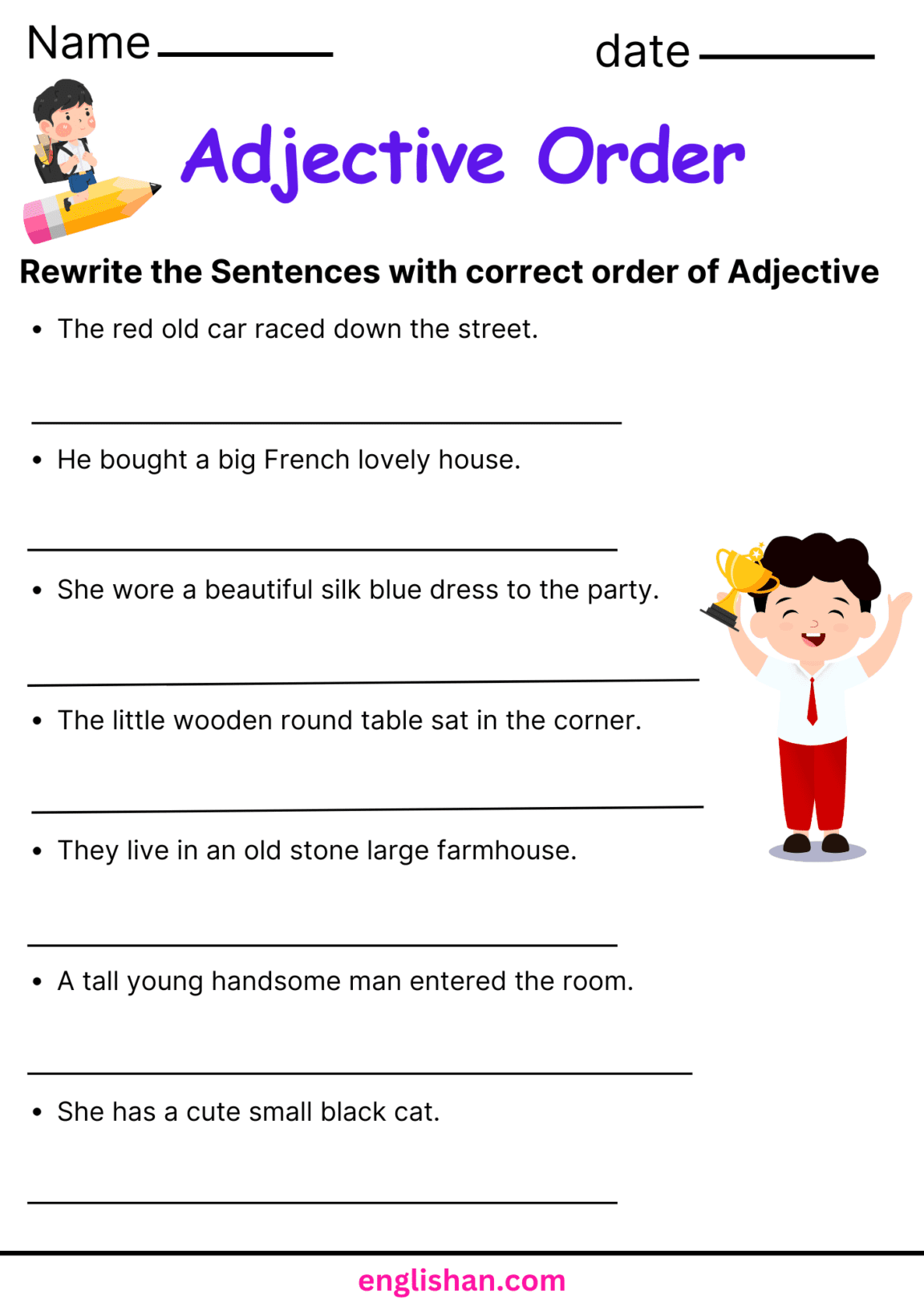
Mastering the Nuances of English: The Indispensable Adjective Order Worksheet
English, a language celebrated for its vast vocabulary and flexible sentence structures, presents both allure and challenge to learners worldwide. While nouns, verbs, and prepositions often take center stage in grammatical instruction, the humble adjective, responsible for adding color, detail, and specificity to our communication, often conceals a complex secret: its order. Unlike some languages where adjectives can appear more freely, English adheres to a remarkably consistent, albeit often subconscious, sequence when multiple adjectives describe a single noun. This "royal order" of adjectives is intuitive for native speakers but can be a significant hurdle for non-natives. This is where the invaluable adjective order worksheet emerges as an indispensable tool, guiding learners from confusion to clarity, and from hesitant phrasing to fluent, natural expression.
The Silent Rules of Adjective Placement: Why Order Matters

Adjectives are descriptive words that modify nouns or pronouns, providing information about their qualities, quantities, or characteristics. They answer questions like "What kind?", "Which one?", or "How many?". A single adjective, such as "a red car" or "a tall building," poses no challenge. The complexity arises when we need to use several adjectives before a noun, for example, "a beautiful old wooden box." Why not "a wooden beautiful old box" or "an old wooden beautiful box"? The latter arrangements sound jarring, even incorrect, to a native English ear.

The reason lies in the inherent, unspoken rules of adjective order. These rules are not explicitly taught to native children but are absorbed through constant exposure and linguistic intuition. For learners, however, this intuition is absent, making a structured approach essential. Incorrect adjective order can lead to awkward phrasing, miscommunication, or simply a non-native sound, even if individual words are grammatically correct. Understanding and practicing this order is crucial for achieving fluency and precision in English.

Unpacking the "Royal Order" of Adjectives: OSASCOMP

The generally accepted order of adjectives in English can be remembered by various mnemonics, with "OSASCOMP" or "NOSASCOMP" (where ‘N’ stands for number/determiner) being the most common. This sequence isn’t rigid in every instance, as not all categories will always be present, but it provides a reliable framework. Let’s break down each category:
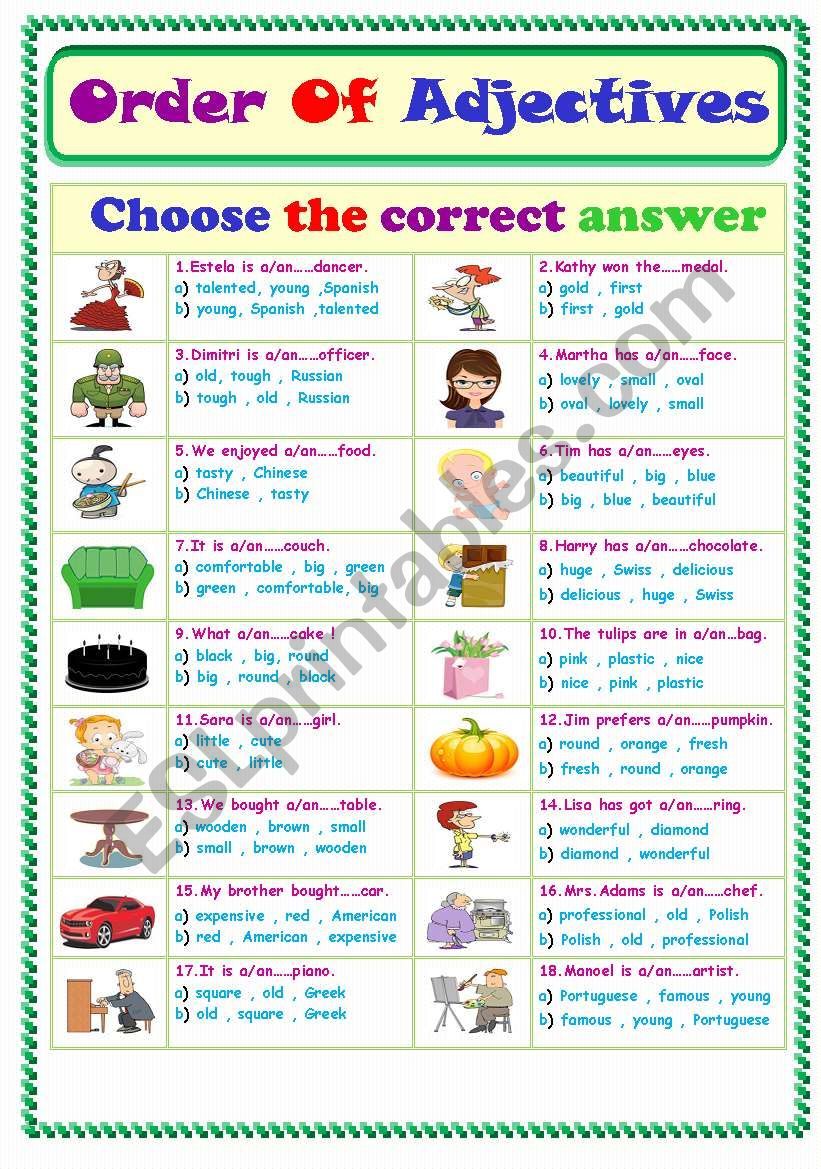
-
Determiner/Quantity (N – Optional first category): These come first and specify how many or which one.
- Examples: two, a, an, the, some, many, few, my, your, this, that.
- Sentence: The two small, old, brown dogs.
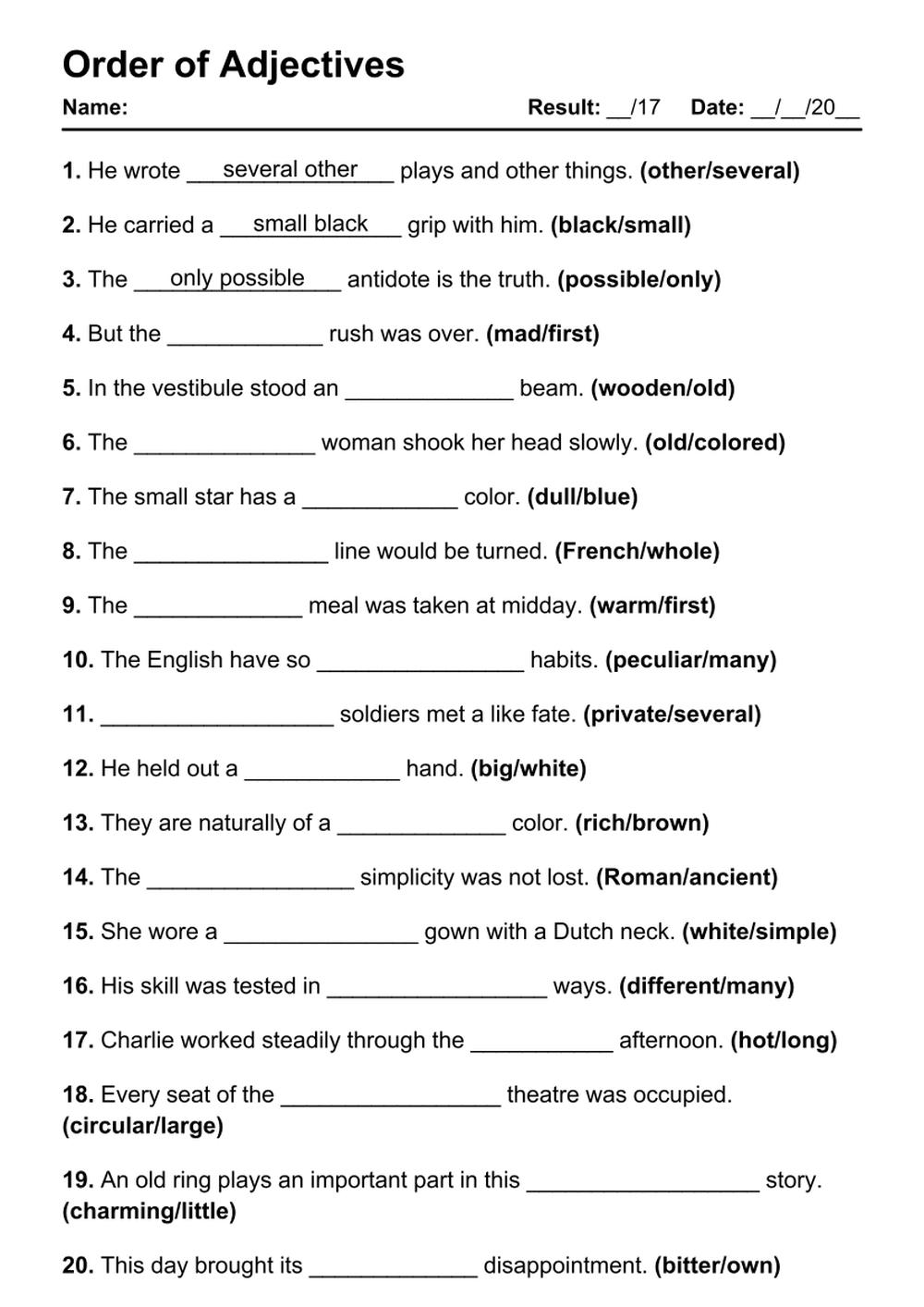
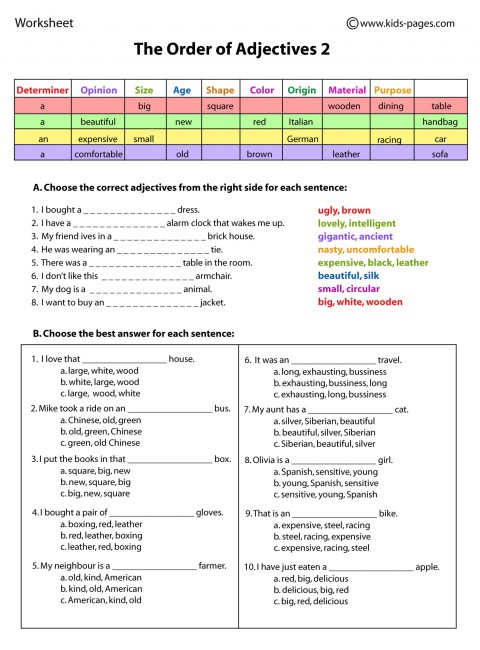
-
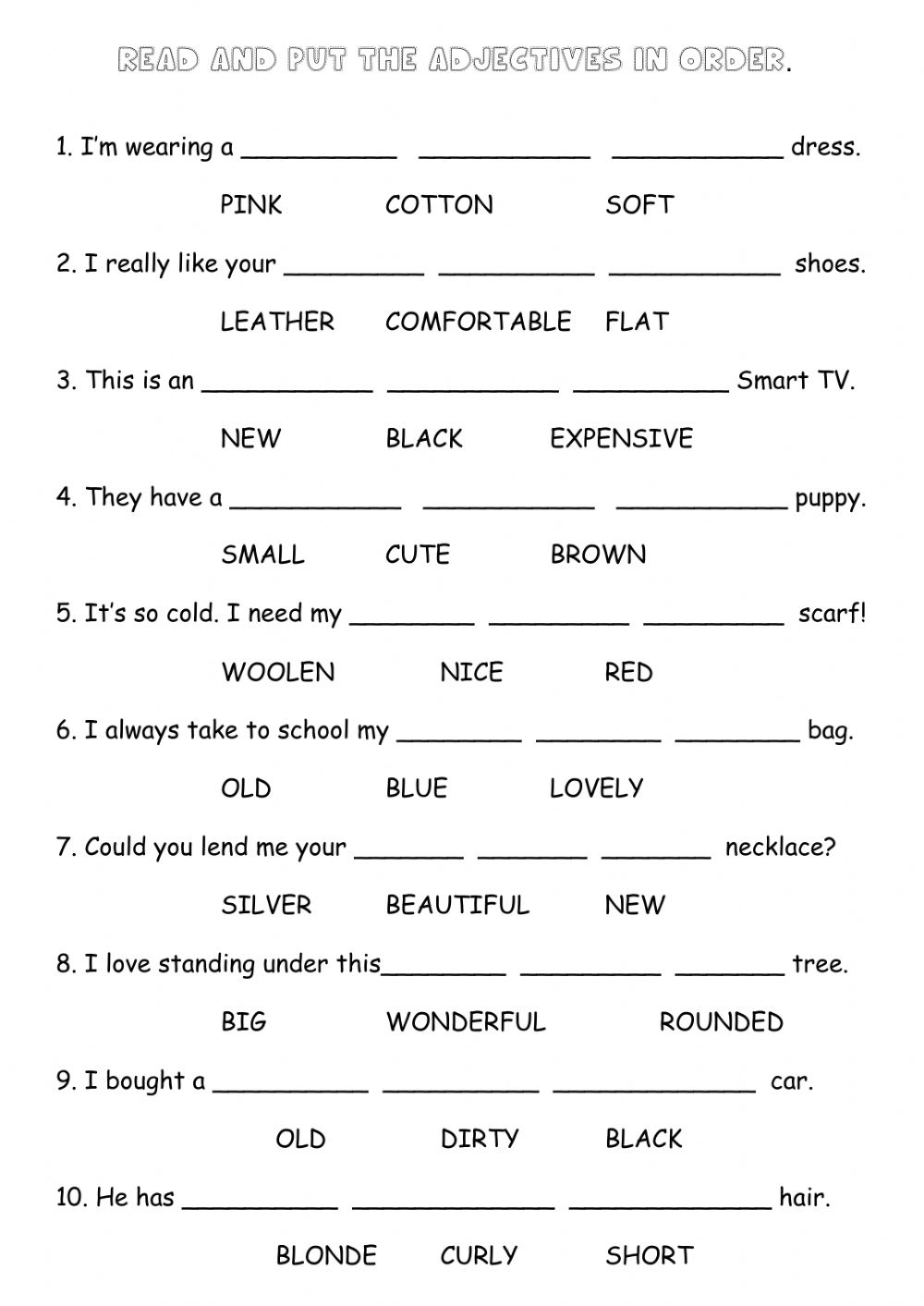
Opinion: These express a subjective judgment or feeling.
- Examples: beautiful, ugly, delicious, charming, good, bad, lovely, awful, interesting, boring.
- Sentence: A beautiful old, wooden box.

-
Size: These describe how big or small something is.
- Examples: big, small, tiny, huge, enormous, miniature, gigantic.
- Sentence: A beautiful small, old, wooden box.
-
Age: These indicate how old something is.
- Examples: old, new, young, ancient, modern, antique, adolescent.
- Sentence: A beautiful small old, wooden box.
-
Shape: These describe the form or outline of something.
- Examples: round, square, triangular, oval, rectangular, crooked, straight.
- Sentence: A beautiful small old round, wooden box.
-
Color: These specify the color.
- Examples: red, blue, green, black, white, yellow, crimson, turquoise.
- Sentence: A beautiful small old round brown, wooden box.
-
Origin: These describe where something comes from.
- Examples: American, French, Italian, Asian, British, Martian, lunar.
- Sentence: A beautiful small old round brown French, wooden box.
-
Material: These indicate what something is made of.
- Examples: wooden, metallic, plastic, cotton, silk, leather, stone, paper.
- Sentence: A beautiful small old round brown French wooden box.
-
Purpose (or Qualifier): These describe what something is used for or its specific type. Often, these are gerunds or nouns acting as adjectives.
- Examples: sleeping (bag), writing (desk), gardening (tools), running (shoes), baking (soda).
- Sentence: A beautiful small old round brown French wooden jewelry box.
Consider the full example: "The two beautiful small old round brown French wooden jewelry boxes." While it’s rare to use so many adjectives in one go, this illustration perfectly demonstrates the established sequence. Deviating from this order, even slightly, can make a sentence sound unnatural.
The Power of the Adjective Order Worksheet
Given the intricate nature of these rules, passive learning through mere exposure is insufficient for most language learners. Active practice is paramount, and this is precisely where an adjective order worksheet proves its worth. A well-designed worksheet transforms abstract grammatical rules into tangible, manageable exercises, allowing learners to internalize the correct sequence through repetition and application.
An effective adjective order worksheet typically incorporates a variety of exercise types to reinforce learning:
- Scrambled Adjectives: Learners are given a noun and a list of adjectives in a random order, and they must arrange them correctly before the noun. For example: "car (red, big, old)" -> "a big old red car."
- Sentence Completion: Sentences with blanks are provided, and learners must insert given adjectives into the correct order.
- Error Identification: Learners are presented with sentences containing incorrectly ordered adjectives and must identify and correct the mistakes. This helps develop a critical eye and an ear for natural phrasing.
- Sentence Construction: Learners are given a noun and several adjectives and tasked with creating original sentences that correctly apply the adjective order. This promotes creative application of the rules.
- Matching Exercises: Adjective phrases are matched with their correct, ordered counterparts, or pictures are matched with descriptions using multiple adjectives.
The systematic nature of these exercises helps learners build confidence and gradually move from conscious application of the rules to more automatic, intuitive usage.
Benefits of Integrating an Adjective Order Worksheet into Learning
Beyond the obvious benefit of mastering a specific grammatical point, regular engagement with an adjective order worksheet offers a multitude of advantages for language learners:
- Reinforces Learning through Practice: The human brain learns best through active engagement. Worksheets provide the necessary repetitive practice without being monotonous, helping to solidify the rules in memory.
- Develops Intuition: While initially learners rely on memorizing OSASCOMP, consistent practice helps them develop an "ear" for what sounds correct, gradually building the intuition native speakers possess.
- Improves Fluency and Naturalness: Correct adjective order makes speech and writing sound more natural and less "foreign." This boosts confidence in communication.
- Enhances Comprehension: Understanding the nuances of adjective placement also aids in comprehending complex descriptions encountered in reading and listening.
- Prepares for Standardized Tests: Many English proficiency exams (TOEFL, IELTS, Cambridge Exams) include grammar sections that test a candidate’s understanding of adjective order. Worksheets provide targeted preparation.
- Caters to Different Learning Styles: Visual learners benefit from seeing the patterns, kinesthetic learners benefit from actively writing and rearranging, and logical learners appreciate the clear, categorized rules.
- Provides Immediate Feedback: Many worksheets come with answer keys, allowing learners to immediately check their work and understand where they made mistakes, facilitating self-correction.
Crafting and Utilizing an Effective Adjective Order Worksheet
For educators, creating a robust adjective order worksheet requires careful consideration. It should include:
- Clear Instructions: Ensure learners understand the task.
- Varied Difficulty: Start with simpler exercises and gradually introduce more complex scenarios (e.g., more adjectives, less common categories).
- Relevant Examples: Use adjectives and nouns that are commonly encountered and useful.
- An Answer Key: Essential for self-study and quick checking.
- Contextual Sentences: Whenever possible, embed adjective order within meaningful sentences rather than just isolated phrases.
For learners, merely completing a worksheet isn’t enough. To maximize its effectiveness:
- Understand the "Why": Don’t just memorize the order; try to grasp why certain categories precede others (e.g., opinion is subjective and broad, while material is specific and inherent).
- Say it Aloud: After ordering the adjectives, say the full phrase or sentence aloud. Does it sound natural? Your ear will become a valuable guide.
- Review Mistakes: Don’t just check the correct answer and move on. Understand why your answer was wrong.
- Integrate into Practice: Once you feel confident, actively try to use multiple adjectives in your own speaking and writing. This is the ultimate test of mastery.
- Seek Feedback: If possible, have a native speaker or a teacher review your sentences.
Conclusion
The order of adjectives in English, while seemingly a minor grammatical detail, is a hallmark of native-like fluency and precision. It adds a layer of sophistication and naturalness to communication that is often overlooked. For learners striving for mastery, navigating this intricate sequence can be daunting. However, with the right tools and a systematic approach, this challenge is entirely surmountable. The adjective order worksheet, whether found online, in a textbook, or custom-made, stands as a critical resource in this journey. By providing structured practice, immediate feedback, and a clear path to understanding, it transforms a complex linguistic rule into an accessible and achievable skill, ultimately empowering learners to speak and write English with greater confidence, accuracy, and natural elegance. Embracing this fundamental aspect of English grammar is not just about avoiding errors; it’s about unlocking a deeper, more nuanced command of the language itself.
